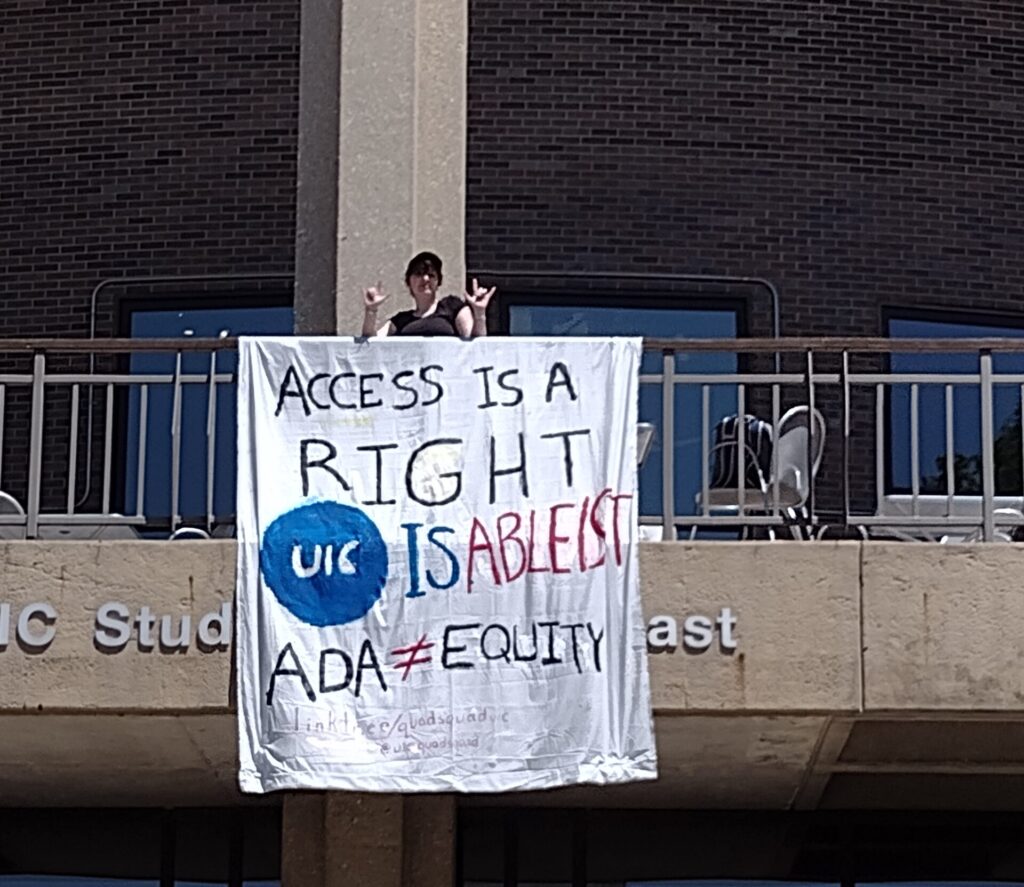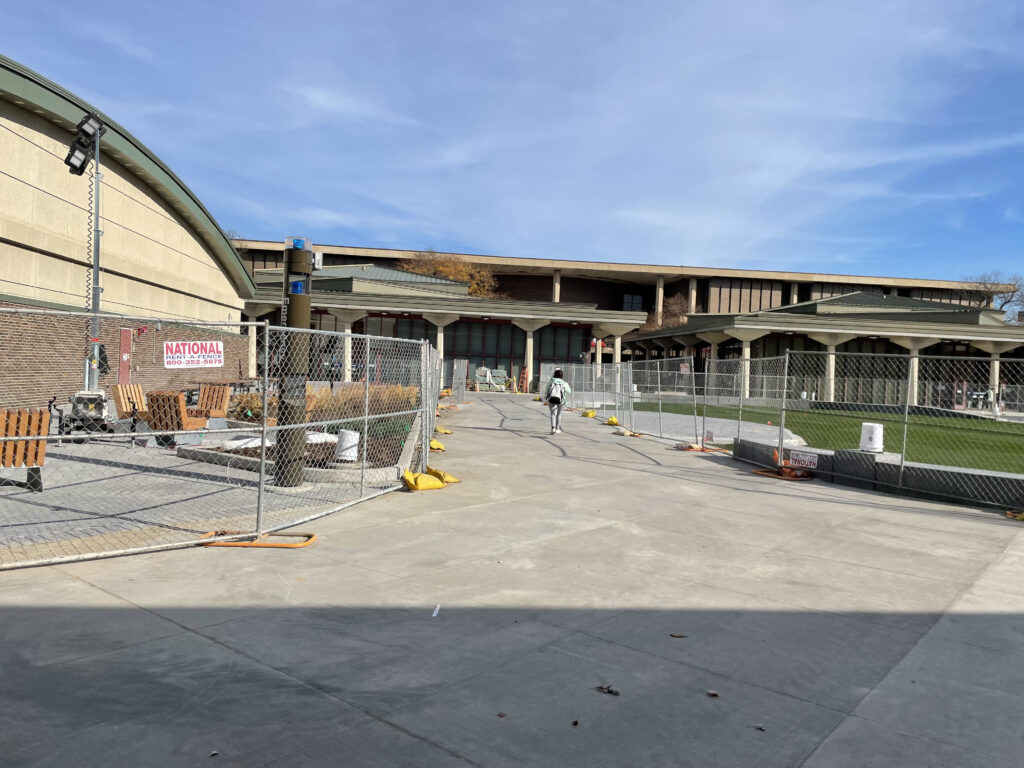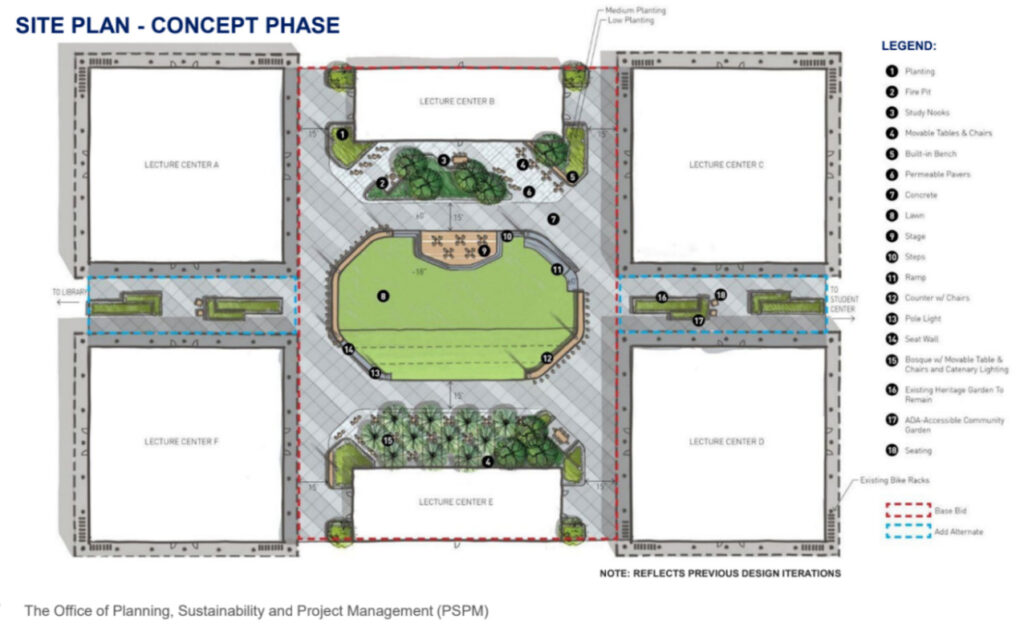Ableist Structures Thrive on Campus: The Journey of Attempting to Stop the UIC East Quad Renovation
by Rubi Valentin and Eyzel Torres
November 30, 2022

If you walked into the University of Illinois at Chicago’s (UIC) East Campus this semester, you would have noticed loud construction vehicles, dust all around, and caution tape sectioning off the middle of our six lecture centers. This space between the centers, known as the Quad to the UIC community, has been under construction since late May 2022. On Oct. 31, 2022, UIC Today announced that UIC’s East Quad would be opened on the first week of November. The construction has finally finished, and after months, students can now walk through the Quad. Fences were up the first week, but have now been taken away for students to use the seating area, tables, and center lawn.
For decades, this space was a utilitarian hub, bustling with activity from student organizations, students commuting to class, and even the Spring 2022 Graduate Employee Organization (GEO) strike. However, that is not the case anymore.
Beneath the new construction lies a history of tension, conflict, and resistance in which students, faculty, and staff worked hard to stop – or at least alter – plans to renovate this community space.

How Did We Get Here
Beginnings of Student Response
According to a presentation by the Office of Planning, Sustainability and Project Management (PSPM) from October 2021, plans for the east campus renovation included more greenery, trees, seating, and a large lawn in the center. As mentioned in the presentation, the changes were informed by a 2015 student survey, but little notice was given to the current student body.
In August 2021, students from UIC’s Heritage Garden (HG), a student-led internship affiliated with the Centers for Cultural Understanding and Social Change (CCUSC), were the first to be informed of the renovation plan. HG members quickly found many problems with one particular aspect of the renovation – a grassy structure in the middle of the Quad. These problems included environmental disruption, as well as physical, cultural and social accessibility issues. In light of these issues, student leaders requested meetings with the renovation plan architects to discuss the plan’s shortcomings.
Part of the renovation plans entailed uprooting the Shikaakwa and Monarch Butterfly Habitat Gardens, which were home to pollinator-friendly and native plants. This became an issue because the renovation interrupted pollinator and habitat conservation efforts.
Furthermore, the Shikaakwa plot had been around since 2015, when the American Indian Center of Chicago shared culturally significant plants with the HG to recognize and respect those who have been in the Chicagoland region for centuries.
“Indigenous land speaks not only to the physical nature, but also to those who live and have lived on the land and this satellite provokes the UIC community to think about the deep history of the region, both ecological and human,” the HG website says in reference to Shikaakwa’s importance. Removing this plot is yet another form of displacement of Indigenous peoples.
Had the UIC administration altered their plans for the quad renovation, they could have departed from their history of displacement. (When UIC moved its campus from Navy Pier to Little Italy, the Italian community that resided in the neighborhood had to leave once the Halsted-Harrison site was handed to UIC by Mayor Richard J. Daley.) However, despite the concerns raised about habitat destruction and Indigenous cultural displacement, the UIC administration did not alter quad plans by removing the center grass structure and maintaining the Shikaakwa plot away from the construction.
Accessibility
The Quad has historically been used as a gathering space for events such as vigils, celebrations, cultural demonstrations, and protests. Replacing this with a grass structure diminishes access to the space and is an attack on the nature of diversity and accessible communal use because it keeps people from freely and easily engaging with the Quad.
The grass structure also poses major physical accessibility issues, particularly due to how the center would obstruct the pathways for students with physical disabilities to move across campus. Although the construction was considered to be ADA (Americans with Disabilities Act) compliant, those with a disability or involved in disability justice movements acknowledge that ADA compliance is the bare minimum in meeting access needs. The walkways, at 15 feet and less than 19ft, would be too narrow to accommodate crowds of students, as presented in the image below.

Regardless of how many folks spoke up about the inaccessibility that a grass structure would provide them, ADA was mentioned countless times as the ultimate guideline for accessibility, completely disregarding the fact that the Quad was already physically accessible to everyone before the patch of grass was introduced into the picture. However, disability activists consider ‘universal design’ to be a much more comprehensive indicator of true accessibility. This means creating spaces that are immediately usable by all people and won’t need “extra additions” like ramps for accommodation. Adding a physical barrier in a once barrier-free space is not a universal design.
While students and faculty were told that ADA compliance is the same as universal design, the lived experiences of countless students, faculty, and staff with disabilities would prove otherwise.
Petition and Changes to the plan
When it was clear that concerns were not being taken seriously despite countless meetings, HG students created a petition in November 2021. By the following semester, almost 900 supporters asked the UIC administration to reevaluate how the grass would negatively impact the community and make changes accordingly.
Between September and November 2021, UIC Project Management met with CCSPD, Heritage Garden, and some members of the CCUSC, as well as other campus stakeholders. In these series of meetings, students and faculty member shared their design concerns. As a result of the concerns shared with CCSPD and other stakeholders, UIC Project Management hired LCM Architects, an Architectural firm known for their integration of accessible design, to review the plan to determine whether it was ADA compliant. LCM Architect reviewed the design and changed the stationary tables and chairs to be moveable, so as to not obstruct the pathways, and a 1/20 ramp was included for access to the stage.
In the spring, after months of asking for updates, UIC officials finally got back to concerned students and faculty with some changes to the Quad’s renovation. These included the addition of a stormwater detention vault, permeable pavers, rain gardens, shade trees, native plantings, and tactile pavement. Additionally, the walkways were made to be slightly wider at 18 feet and 20 feet around the lawn. While students were pleased by these improvements, the accessibility issue itself still wasn’t resolved, and the grassy center remained where it was. Student organizers pitched ideas to the University for modification, such as including a walkway that goes through the grass structure, but no compromises were made. Eventually, student organizations, campus workers and faculty collectively organized resistance to the Quad renovations.
Direct Action and Community Building on Campus – Timeline of Events
April 28, 2022:
Students were not satisfied with the plan’s inadequate revisions and decided to take direct action. During finals week of the Spring 2022 semester, students came together at the Quad for a rally organized by various campus organizations. They made signs to put across campus, gave speeches about memories they had at the Quad, and spoke up about why the renovation was harmful to the UIC community. This rally was an opportunity to reach out to the masses of passing students, and to take up space at the Quad to prevent construction.
In tandem with the students, there were faculty members that supported the resistance against the Quad renovation. Professors from Global Asian Studies (GLAS), Gender and Women’s Studies (GWS), and CCUSC directors created a faculty solidarity letter and a petition to support student efforts against the renovation. That same day, the Chancellor’s Committee on the Status of Persons with Disabilities (CCSPD) met and voted against the Quad renovations 10-0 with 4 abstaining.
May 5, 2022:
The CCSPD called for a town hall after catching wind of community and students’ concerns over the inaccessibility of the Quad plans. According to the CCSPD’s mission statement, they “[promote] the academic, professional, cultural, and social development of faculty, staff, and students with disabilities at the University of Illinois at Chicago.” CCSPD hosted this town hall so that concerned community members could address access issues regarding the renovation with Vice Chancellors John Coronado and Rex Tolliver.
However, despite the overwhelming opposition to the Quad renovation plans displayed at the town hall, administrators did not change their perspectives. Comments expressing concerns over accessibility were ignored or given robotic answers. The recording and additional materials are available on the CCSPD website. Below is a comment made by UIC student Yael Lenga during the town hall.
The town hall ended with a call to action for the administration to properly address the faculty and student petitions. Chancellor Micheal Amiridis was not present during the town hall, and responded a week later with a letter to the CCSPD in which he stated the following:
“While I respect your preference, I am unable to find a strong basis for the need for another set of changes and delays… I think that we have already exhausted the relevant issues and I’m concerned that any further delays will put the entire project at risk.”
May 16, 2022:
This response fueled the people’s frustration in the resistance effort, leading to a final step to grab the administration’s attention— staging a sit-in. Students, community members, and faculty came together as early as 7 AM in the center of the Quad to postpone the construction. They brought blankets, snacks, water, and art supplies to take up the space on the Quad until late afternoon. However, the sit-in lasted only a few days due to limited capacity. On May 23rd, only a week after the sit-in, UIC Today released an announcement that the Quad construction would begin.
July 25, 2022:
UIC Today released an announcement on the Quad construction delay. According to the article, there were “Unknown underground utility and soil issues; Limited concrete supply caused by a material producer labor union strike; and Supply chain issues causing extremely long lead times for exterior light fixtures and outdoor furniture.” For weeks, the construction was in limbo. The renovated Quad was planned to be ready by August for the Fall semester. However, the opening was pushed until November.
Conclusion
After months of construction, the Quad is now open to students. Students bustling from class to class don’t have to continue to loop around the lecture centers, but can finally pass through the Quad. With winter approaching, there are no students found in the center grassy lawn, as suggested in the renders for UIC’s Master Plan. However, it has been alluded to from meetings with UIC administration and renderings that it will be converted into a skating rink.
Although the administration made inaccessible renovations despite activism from UIC staff and students for the Quad to be a flat, uniform surface, the resistance wasn’t a lost effort. There were small victories; adjustments were still made to the plan and wouldn’t have been implemented without community organizing surrounding access concerns. It provided space for UIC community members to come together and build community with one another.
There is a strong, extensive history of activism at UIC, and it is the reason why students have the resources they do. There are plenty of examples, from CCUSC to the satellite gardens, to ethnic studies departments and student resources. These resources became available after students and faculty advocated for those amenities. UIC wouldn’t be the same campus without years of sit-ins, protests, and arrests. Collective struggle demonstrates the UIC community’s power and enables it to create social change within the university system. As long as UIC community members continue to stand up for themselves, they will be able to create meaningful change on campus.
